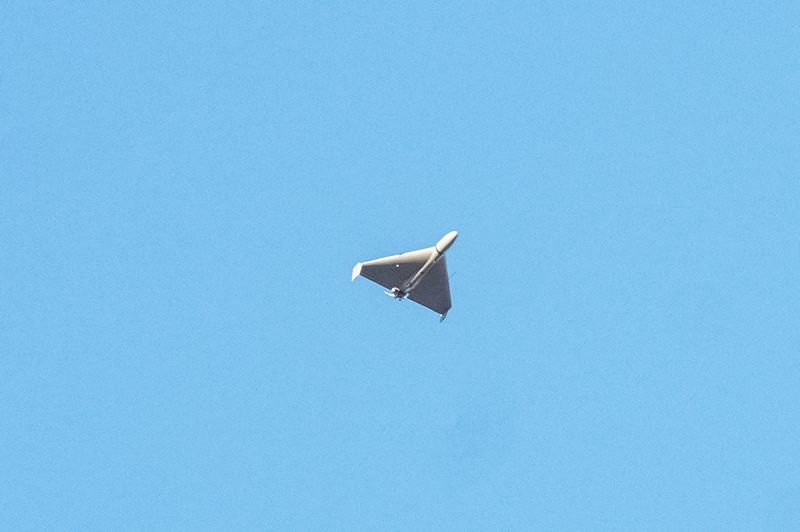By Michael Georgy
DUBAI (Reuters) - Iran has promised to provide Russia with surface to surface missiles, in addition to more drones, said Iranian officials, a move that has infuriated the United States and other Western powers which are backing Ukraine in the war.
The weapons could provide a significant boost for Russia's failing war efforts against Ukraine but Iran's clerical rulers face mounting international pressure over their military alliance with Moscow.
WHAT ARE IRAN’S MISSILE AND DRONE CAPABILITIES?
Iran has developed a large domestic arms industry in the face of international sanctions and embargoes that had barred it from importing weapons, including drones and missiles it sees as a vital form of protection from arch-enemy Israel and the United States, which has soldiers stationed at bases in the region.
Although Western military analysts say Iran sometimes exaggerates its capabilities, drones are a key element in Tehran's border surveillance, especially the Gulf waters around the Strait of Hormuz, through which a fifth of the world's oil supply flows.
Iran and the regional forces it backs have increasingly relied in recent years on drones in Yemen, Syria and Iraq, where it has spread its influence through proxies. Saudi Arabia and the United States have said they believe Iran was behind a drone and missile attack on prized Saudi oil facilities in 2019, which Tehran denies.
The Islamic Republic says its drones are the region's most powerful. In addition to surveillance, they can be used for attacks, either by dropping munitions or as so-called "kamikaze drones" that fly into a target and blow themselves up. Its advanced long-range suicide drone is designed to hit Israel's Tel Aviv.
Iran says its ballistic missiles, with a range of up to 2,000 km (1,200 miles), are an important deterrent and retaliatory force against the United States, Israel and other potential regional targets. It denies seeking nuclear weapons.
The programme, which contains about 1,000 short-and medium range ballistic missiles, is one of the largest deployed in the Middle East.
The Arms Control Association says Iran's short-range and medium-range ballistic missiles include Shahab-1, with an estimated range of 300 km, the Zolfaghar (700 km); Shahab-3 (800-1,000 km), Emad-1, a missile under development (up to 2,000 km) and Sejiil, under development (1,500-2,500 km).
Iran also has cruise missiles such as Kh-55, an air-launched nuclear-capable weapon (up to 3,000 km), and the advanced anti-ship missile the Khalid Farzh, capable of carrying a 1,000 kg warhead.
The United States fears long-range ballistic technology used to put satellites into orbit could also be used to launch nuclear warheads. Tehran denies such plans.
WHY HAS IRAN BUILT UP ITS OWN MISSILE AND DRONE CAPABILITY?
With U.S. forces stationed at bases in the region, and Israeli military superiority, Iran stepped up its efforts to create missiles and drones and supply its proxies despite crippling U.S. sanctions that have devastated its economy.
Iran's air force is weak. Most of its jets are decades old and difficult to maintain. Producing drones and missiles is seen as a cheaper way for the Iranian military to protect the country.
Iranian hardware in Syria and Yemen has improved in the last decade. Yemen’s Iranian-backed Houthis have significantly increased their UAV attacks, bombing airports and oil facilities in Saudi Arabia, a main rival of Iran.
WHY IS IRAN SUPPLYING RUSSIA?
The Islamic Republic's clerical leaders are keen to strengthen strategic relations with Russia against an emerging, U.S.-backed Gulf Arab-Israeli bloc that could shift the Middle East balance of power further away from Iran.
Emboldened by high oil prices since the Ukraine war, Iran is betting that with Russia's support it could pressure Washington to offer concessions for the revival of its 2015 nuclear deal with world powers.
Forming a real alliance with a superpower which shares anti-Western views and is not afraid of pushing such views on the battlefield is a strategic move designed to show Iran is not isolated.
WHAT IRANIAN WEAPONS HAS RUSSIA USED ON UKRAINE SO FAR?
Russia launched dozens of "kamikaze" drones on Ukraine on Monday, hitting energy infrastructure and killing five people in the capital Kyiv. Ukrainians have nicknamed them "mopeds" for the loud whirring noise their engines make as they fly overhead.
Ukraine says they are Iranian-made Shahed-136 attack drones - loitering munitions that cruise towards their target before plummeting at velocity and detonating on impact. Kyiv moved to cut ties with Iran because of their use on Tuesday.
COULD IRAN FACE MORE SANCTIONS AND WOULD THEY HAVE AN IMPACT?

Western powers are expected to impose more sanctions on Iran. European Union governments have provisionally agreed to impose sanctions on eight people and entities over the use of Iranian-made drones in Russian strikes on Ukraine, three EU diplomats said.
The Islamic Republic has learned to survive decades of sanctions and has tight control over its supply chains.
